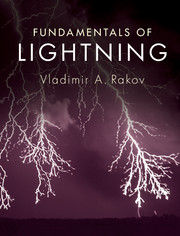Book contents
- Frontmatter
- Dedication
- Contents
- Preface
- 1 Types of lightning discharges and lightning terminology
- 2 Incidence of lightning to areas and structures
- 3 Electrical structure of thunderclouds
- 4 Properties of the downward negative lightning discharge to ground
- 5 Calculation of lightning electromagnetic fields
- 6 Modeling of the lightning return stroke
- 7 Measurement of lightning electric and magnetic fields
- 8 Electromagnetic methods of lightning location
- 9 Lightning damaging effects and protective techniques
- Appendices
- Appendix 1 How is lightning initiated in thunderclouds?
- Appendix 2 Reconstruction of sources from measured electrostatic field changes
- Appendix 3 Derivation of exact equations for computing lightning electric and magnetic fields
- Appendix 4 Compact intracloud discharges (CIDs)
- Appendix 5 Is it true that lightning never strikes the same place twice?
- Appendix 6 Is it possible to use lightning as an energy source?
- Appendix 7 Lightning safety
- Appendix 8 Lightning makes glass
- Appendix 9 Bibliography on triggered lightning experiments and natural lightning observations at Camp Blanding, Florida (1995–2014)
- Glossary
- References
- Index
Appendix 8 - Lightning makes glass
from Appendices
Published online by Cambridge University Press: 05 April 2016
- Frontmatter
- Dedication
- Contents
- Preface
- 1 Types of lightning discharges and lightning terminology
- 2 Incidence of lightning to areas and structures
- 3 Electrical structure of thunderclouds
- 4 Properties of the downward negative lightning discharge to ground
- 5 Calculation of lightning electromagnetic fields
- 6 Modeling of the lightning return stroke
- 7 Measurement of lightning electric and magnetic fields
- 8 Electromagnetic methods of lightning location
- 9 Lightning damaging effects and protective techniques
- Appendices
- Appendix 1 How is lightning initiated in thunderclouds?
- Appendix 2 Reconstruction of sources from measured electrostatic field changes
- Appendix 3 Derivation of exact equations for computing lightning electric and magnetic fields
- Appendix 4 Compact intracloud discharges (CIDs)
- Appendix 5 Is it true that lightning never strikes the same place twice?
- Appendix 6 Is it possible to use lightning as an energy source?
- Appendix 7 Lightning safety
- Appendix 8 Lightning makes glass
- Appendix 9 Bibliography on triggered lightning experiments and natural lightning observations at Camp Blanding, Florida (1995–2014)
- Glossary
- References
- Index
Summary
This appendix is based on the Domenic Labino Lecture given by the author of this book at the 1999 Glass Art Society meeting in St. Petersburg, Florida.
Introduction
Mother Nature makes glass each time a large amount of energy is released during a sufficient period of time at the Earth's surface, provided that the soil composition is suitable for making glass. The latter condition is satisfied, for example, by sandy soil, with the resultant natural glass being silica glass named “lechatelierite” after the French chemist Henry Le Châtelier (1850–1936). There are two phenomena that are responsible for making natural glass on Earth: meteorites and lightning. Glass that is made as a result of the collision of a meteorite with the Earth's surface is called meteoritic glass or tektite. Glass (a glassy object, to be exact) that is made as a result of a cloud-to-ground lightning discharge is called a fulgurite (from the Latin “fulgur,” which means “lightning”). Fulgurites come in a great variety of forms and can be viewed as nature's own works of art. It is worth noting that lechatelierite (natural silica glass) is not present in obsidian, a glass-like material associated with volcanic activity. On the other hand, volcanic activity is known to generate lightning which, if it strikes sandy soil, may produce a fulgurite. Silica glass has been also made as a result of nuclear explosions. In 1945, the first nuclear bomb (equivalent to 18,000 tons of TNT) was detonated in the New Mexico desert. The explosion formed a crater about 700 m in diameter, glazed with a dull gray-green silica glass. This glass was named “trinitite” after Trinity Site where the first nuclear bomb test was conducted.
Characterization of lightning
On average, some tens to 100 lightning discharges occur every second on the Earth. Only about one quarter of them involve the ground (others occur in the cloud, between clouds, or between cloud and clear air) and can potentially make fulgurites. Some parts of Florida receive more than 12 lightning strikes per square kilometer per year. This is the highest level of lightning activity in the United States.
- Type
- Chapter
- Information
- Fundamentals of Lightning , pp. 218 - 224Publisher: Cambridge University PressPrint publication year: 2016



